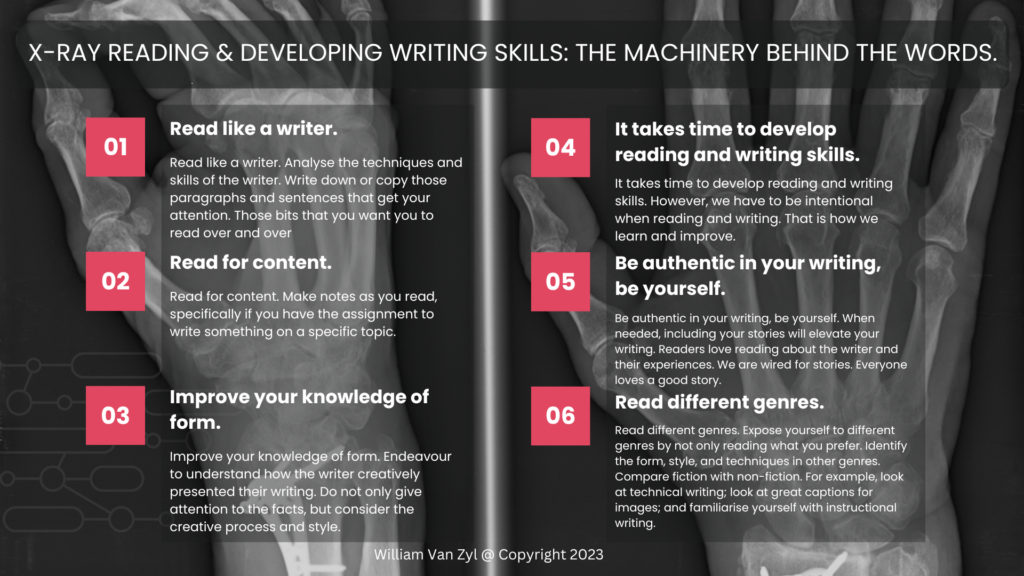
By William Van Zyl.
Published January 24, 2023.
You can’t see the inside of an engine. You can hear, smell, and feel it, but you can’t see the inside rock, spin, and roll. The spinning cogs, the rotating gears and the rocking rods vibrate harmonically together to produce power. What a machine. Fire and lightning explode in its belly over and over, pushing and turning like a buffalo in a fight-for-life with a lion. There is a roar and a groan! You know the machine is spinning; you experience the muscle and the power in your hands. You have the control – it’s under your foot.
——————————0——————————-
The engine roars like a mighty river from line one. The sparks fly in the first paragraph. It coughs and spurts in paragraph 3. The current draws you as you wade deeper in, paragraph after paragraph. The gears and cogs are strategically placed to perform their best. The word-engineer had spent lots of design time on it – meticulously setting up every part of the machine in the right place. Fine-tuned. In the hot combustion block – with delicate timing and finesse – the belts around the pulleys and cogs turn with Swiss precision. From page to page, it turns, spins, and hums. On page 2, the cogs and rods are noisy at first; oils squirt into the carcass, smashing out a cacophony of metallic sounds. And, then – on page 3 – the engine runs as if it is eating grease. The lively rhythm of the rumba taps and clinks; the accelerator is pressed in, the pistons move with gusto in paragraph 6 on page 4. All eight of them are under severe pressure. The percussion instruments intricately fill in the gaps with swooshes and gentle strokes. Did I hear a slight rattle? On page 5, there is an unexpected backfire. Boom. The muffler and carburettor communicate with staccato chokes and puffs. The butterfly in the carb flutters under the heavy machine – then it chokes – fighting for more oxygen. Then the harmony returns; it soothes and massages the eyes of the reader. The singer joins in at the opportune moment on page 6. It is perfect. The heart is oiled. The soul sings all over page 7.
Have you read a story, an article, or non-fiction that makes your heart sings? You stop momentarily. You are surprised by how the writer has described the scene, background, and context and how they presented the story or the facts uniquely, creatively and innovatively. The introduction stunned you. The different ideas and concepts are moulded and shaped to fit seamlessly together. It creates unity. I am referring to the machinery behind the text, the writing skills, and the writer’s artistry.
Why not develop your reading skills; I am referring to your x-ray reading skills. Be alert to those parts of a story that makes you want to keep reading. What causes the effect – the pulsing symphonic words and sounds – of not being able to put the story or the article down? Next time you hit such a spot, mark it. Maybe copy and paste it into a file on your computer, or write it down in a book. Then, when you have time, return to it. Reflect on the techniques and skills used by the writer. Try and figure it out. Why not apply those techniques in your writing?
Table of Contents
How can you improve your x-ray reading and writing?
Writers read for content and form.
- Read like a writer. Analyse the techniques and skills of the writer. Write down or copy those paragraphs and sentences that get your attention. Those bits that you want you to read over and over.
- Read for content. Make notes as you read, specifically if you have the assignment to write something on a specific topic.
- Improve your knowledge of form. Endeavour to understand how the writer creatively presented their writing. Do not only give attention to the facts, but consider the creative process and style.
- It takes time to develop reading and writing skills. However, we have to be intentional when reading and writing. That is how we learn and improve.
- Be authentic in your writing, be yourself. When needed, including your stories will elevate your writing. Readers love reading about the writer and their experiences. We are wired for stories. Everyone loves a good story.
- Read different genres. Expose yourself to different genres by not only reading what you prefer. Identify the form, style, and techniques in other genres. Compare fiction with non-fiction. For example, look at technical writing; look at great captions for images; and familiarise yourself with instructional writing.
Why not improve your reading and writing?

Copyright © 2023 William Van Zyl
The Machinery behind the Words.
All rights reserved. This article/eBook or any portion
thereof may not be reproduced or used in any manner
whatsoever without the express written permission of the
publisher except for the use of brief quotations in a book review.
Published by Five House Publishing (New Zealand) on January 24, 2023
More articles, eBooks, lessons, and resources are available at Five House Publishing.
Read more online: https://fivehousepublishing.com/
More about the Author: http://williamvanzyl.com/
Podcasts:
The Extravagant Podcast. Available on Spotify, Podbean, Audible, and more.
https://feed.podbean.com/williamvzyl/feed.xml
https://williamvzyl.podbean.com/